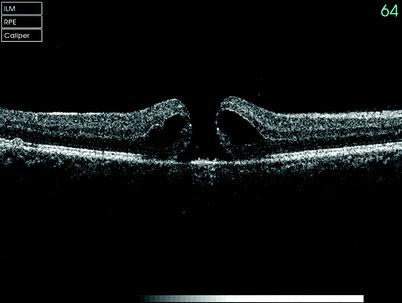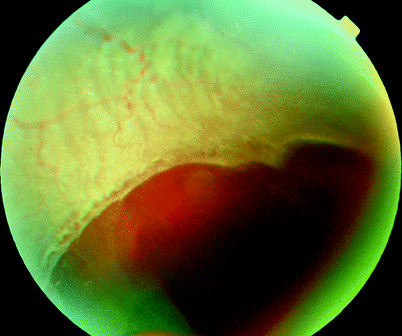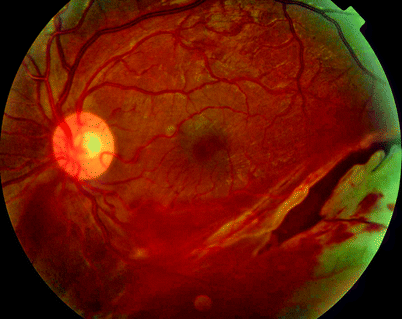(1)
Department of Ophthalmology, St. Thomas’ Hospital, London, UK
14.1 Introduction
14.2 Classification
14.3 Contusion Injuries
14.3.1 Clinical Presentation
14.3.2 Types of Retinal Break
14.3.3 Surgery
14.3.4 Visual Outcome
14.4 Rupture
14.4.1 Clinical Presentation
14.4.2 Surgery
14.4.3 Visual Outcome
14.5 Penetrating Injury
14.5.1 Clinical Presentation
14.5.2 Surgery
14.5.3 Visual Outcome
14.6 Trauma Scores
14.7.1 Clinical Presentation
14.7.2 IOFB Materials
14.7.3 Surgery
14.7.4 The Primary Procedure
14.7.5 PPV: The Anterior Segment
14.7.6 PPV: The Posterior Segment
14.7.7 The Magnet
14.7.8 Visual Outcome
14.7.9 Siderosis
14.8 Perforating Injury
14.11 Phthisis Bulbi
14.12 When Not to Operate
14.12.1 At Presentation
14.12.2 Postoperatively
14.13 Summary
Abstract
Ocular trauma remains a leading cause of visual loss, most often affecting men (on average five males are affected to one female). Patients are usually aged less than 30 years, and trauma is often associated with alcohol and illicit drug usage (Parver et al. 1993). In the elderly, males and females are equally involved (Tielsch et al. 1989). Incidence has been estimated as 3:10,000 of population (Tielsch and Parver 1990; Canavan et al. 1980). Severe injuries account for 5 % of all eye injuries (Schein et al. 1988). Aetiology is variable, but certain associations are common, for example, assault, sport, children at play, road traffic accidents and industrial, domestic and war injuries (Liggett et al. 1990a; Khatry et al. 2004; Appiah 1991; Ahmadieh et al. 1993). The patterns of ocular trauma are constantly changing depending on social, demographic and geographical variations. The clinical characteristics vary widely. Intraocular foreign bodies are common in war (Ahmadieh et al. 1993) and road traffic accidents especially when car seat belts are not worn (Ghoraba 2002). In children, sharp objects are commonly implicated, and the complication of amblyopia limits visual recovery (Alfaro et al. 1994a). The wearing of spectacles has been found to be protective (May et al. 2000).
Electronic supplementary material
The online version of this chapter (doi:10.1007/978-3-642-31872-6_14) contains supplementary material, which is available to authorized users.
14.1 Introduction
Ocular trauma remains a leading cause of visual loss, most often affecting men (on average five males are affected to one female). Patients are usually aged less than 30 years, and trauma is often associated with alcohol and illicit drug usage (Parver et al. 1993). In the elderly, males and females are equally involved (Tielsch et al. 1989). Incidence has been estimated as 3:10,000 of population (Tielsch and Parver 1990; Canavan et al. 1980). Severe injuries account for 5 % of all eye injuries (Schein et al. 1988). Aetiology is variable, but certain associations are common, for example, assault, sport, children at play, road traffic accidents and industrial, domestic and war injuries (Liggett et al. 1990a; Khatry et al. 2004; Appiah 1991; Ahmadieh et al. 1993). The patterns of ocular trauma are constantly changing depending on social, demographic and geographical variations. The clinical characteristics vary widely. Intraocular foreign bodies are common in war (Ahmadieh et al. 1993) and road traffic accidents especially when car seat belts are not worn (Ghoraba 2002). In children, sharp objects are commonly implicated, and the complication of amblyopia limits visual recovery (Alfaro et al. 1994a). The wearing of spectacles has been found to be protective (May et al. 2000).
14.2 Classification
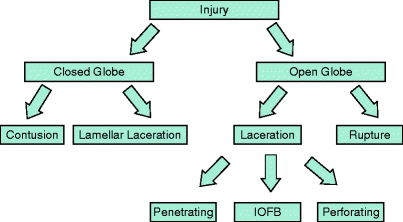
Fig. 14.1
The Birmingham Eye Trauma Terminology is a useful method for classifying trauma and allows adequate communication between surgeons
The Birmingham Eye Trauma Classification (BETT) is a useful system to allow the organisation of the clinical presentation of these patients and aid communication of findings between clinicians (Kuhn et al. 1996).
It is worth learning and using the terminology from BETT:
1. Eye wall | Sclera and cornea |
2. Closed globe injury | No full-thickness wound of eye wall |
3. Open-globe injury | Full-thickness wound of the eye wall |
4. Contusion | There is no (full-thickness) wound |
5. Lamellar laceration | Partial-thickness wound of the eye wall |
6. Rupture | Full-thickness wound of the eye wall, caused by a blunt object |
7. Laceration | Full-thickness wound of the eye wall, caused by a sharp object |
8. Penetrating injury | Entrance wound or wounds from object or objects |
9. IOFB | Intraocular foreign body in the eye |
10. Perforating injury | Entrance and exit wounds from the same object |
The BETT, however, is less good for describing the mode of injury which can be from blunt objects as in assaults from fists, feet, wooden bats or from other causes, for example, balls in sport, air bags (Han 1993; Pieramici and Kuhn 2003; Pearlman et al. 2001), paintballs (Mason et al. 2002) and bungee elastic cords (Cooney and Pieramici 1997), from sharp instruments such as broken glass, knives or fragments of metal.
Trauma was a very early indication for the use of vitrectomy (Peyman et al. 1980; Coleman 1982; Conway and Michels 1978; Ryan 1978; Mody et al. 1978; Mandelcorn 1977; Hutton et al. 1976), with increased experience and availability of techniques leading to improved success rates (Pieramici et al. 1996a).
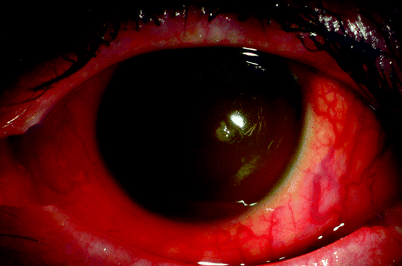

Fig. 14.2
This patient’s cornea shows severe staining of the corneal stroma after hyphaema from a severe injury to the eye from an assault. This can make visualisation of the posterior segment difficult during PPV. Usually with corneal opacities, it remains possible to visualise through a segment of clear cornea, in rare cases a keratoprosthesis (e.g. Ekhart) is required
14.3 Contusion Injuries

Fig. 14.3
This patient was struck by a weight from a fishing line and has suffered a blunt injury which damaged the upper lid. It caused a hyphaema and also an optic nerve avulsion
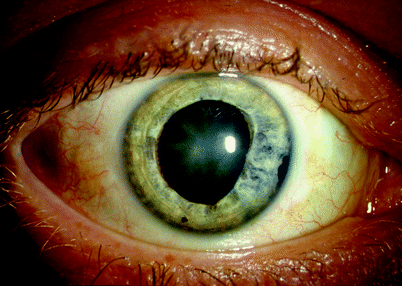
Fig. 14.4
This patient has suffered an iris root dialysis from a blast injury during a terrorist bomb attack. The eye was hypotonous for many weeks post injury but finally recovered to 20/20 after a cataract extraction
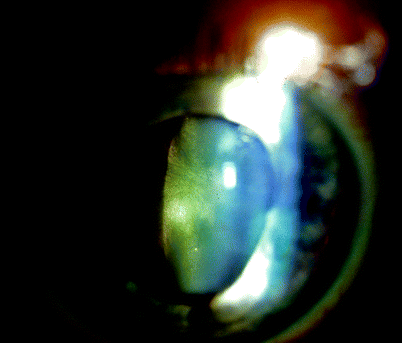
Fig. 14.5
The patient suffered a typical traumatic sunflower cataract
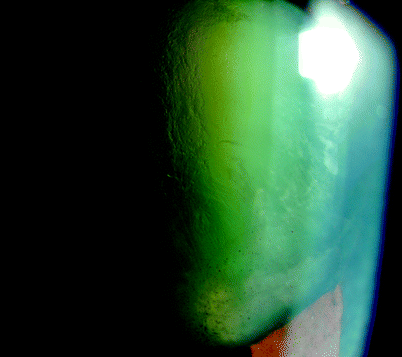
Fig. 14.6
The vitreous in the AC in this patient with contusion injury indicates zonular dehiscence. The patient had lenticulodonesis which was too unstable for routine phacoemulsification cataract extraction and required PPV and cataract extraction with anterior chamber lens insertion
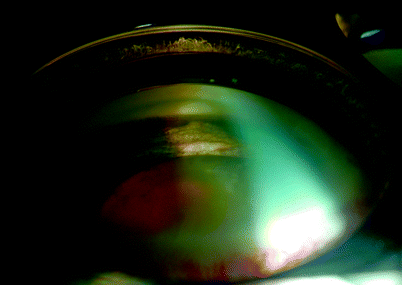
Fig. 14.7
Angle recession is visible in a patient who suffered a blunt injury whilst shaking out wet clothing when the metal zip of a shirt hit her eye
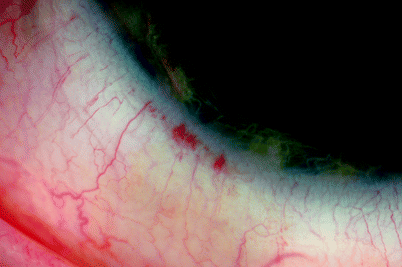
Fig. 14.8
Paintball gaming is associated with blunt injuries to the eye when the participants remove their goggles to clear them of condensation and are struck in the eye by paint pellet. This patient suffered an iridodialysis and rupture in the posterior lens capsule which caused a rapid-onset cataract (see Fig. 14.9)
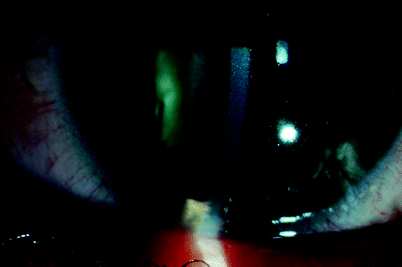
Fig. 14.9
See previous figure
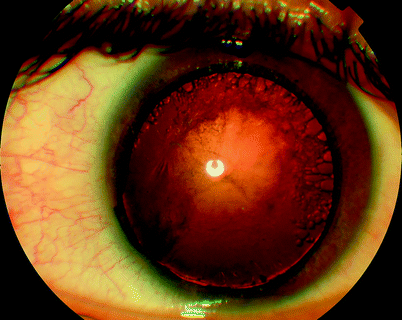
Fig. 14.10
Two months after the injury with the paintball an extensive posterior subcapsular cataract has developed

Fig. 14.11
This patient was punched in the eye causing a subretinal haemorrhage which is likely to have an underlying choroidal haemorrhage, vision was 20/20
14.3.1 Clinical Presentation
Presentations of contusion injury:
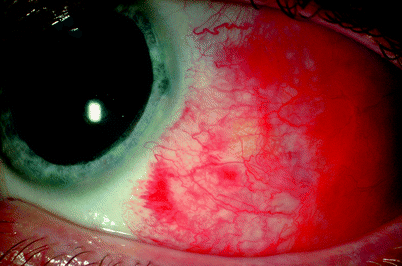

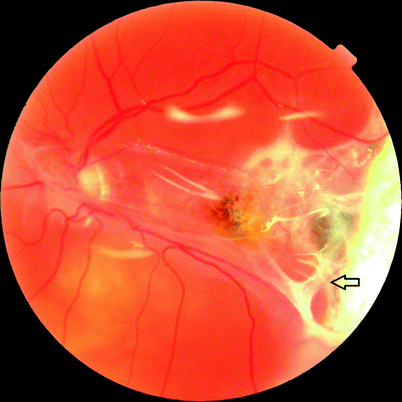


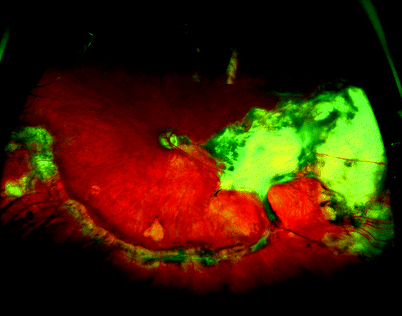

1.
Subluxated or dislocated lens
2.
Vitreous haemorrhage
3.
Macular oedema and commotio retinae
4.
Retinal detachment
(a)
Dialysis usually with a ‘bucket handle’ vitreous base avulsion
(b)
Giant retinal tear
(c)
Ragged retinal tear in an area of commotio retinae
(d)
Pars ciliaris tear
5.
Late retinal pigment epithelial changes
6.
Macular hole
7.
Choroidal rupture, haemorrhage
8.
Choroidal neovascular membrane
9.
Optic nerve avulsion

Fig. 14.12
This eye was struck by squash ball. There are minimal signs on the exterior of the eye

Fig. 14.13
The eye was filled with vitreous haemorrhage and rolled up retina could be seen near the macula

Fig. 14.14
After removal of the vitreous haemorrhage, a large area of severe corioretinal damage was found. PVR developed postoperatively causing folding of the retina over the disc and transretinal fibrosis at the edge of the scar

Fig. 14.15
Notice removal of the transretinal fibrosis and flattening of the fold over the optic disc after surgery

Fig. 14.16
After removal of the PVR membranes and inferior retinectomy, the retina is flattened

Fig. 14.17
Squash ball injury; 10 months after removal of the silicone oil, the retina remains stable, the traumatic scar in the macular and temporal retina can be seen. Note the retinectomy edge inferiorly and nasally

Fig. 14.18
These images show the evolution of pigmentary changes and OCT findings in the retina over 6 months from a contusion injury from a football hitting the eye, early scan on the bottom and late on top
Contusion injuries occur when the eye is struck by an object, but the eye wall remains intact. This is common in assaults from the use of fists or feet or from injury from balls in sport but can also be encountered from air bags (Han 1993; Pieramici and Kuhn 2003; Pearlman et al. 2001), paintballs (Mason et al. 2002) and bungee elastic cords (Cooney and Pieramici 1997). In mild injury, the retina shows commotio (whitening) which clears after a few days, sometimes accompanied with macular oedema (Berlin’s oedema). Vision can be lost from macular oedema, commotio retinae, choroidal rupture, lens dislocation, glaucoma, hyphaema, retinal detachment, choroidal haemorrhage and vitreous haemorrhage. Corneal staining can result from hyphaema and choroidal neovascular membrane from choroidal rupture. The retina may show late retinal pigment epithelial changes from diffuse retinal damage.
Lens dislocation may occur in patients with pseudoexfoliation or pseudophakia or in highly myopic eyes.
Ultrasound is helpful to assess the type of haemorrhage in patients with medial opacities to determine prognosis for vision and surgical options. Traumatic macular hole formation may occur.
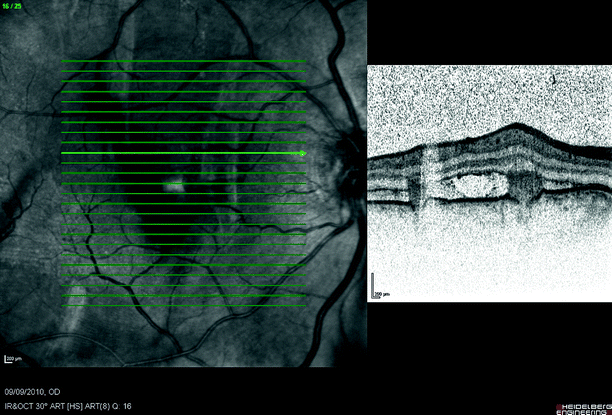
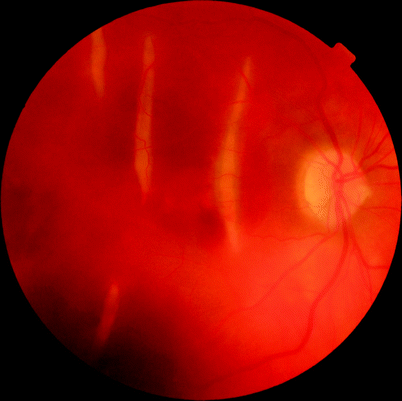
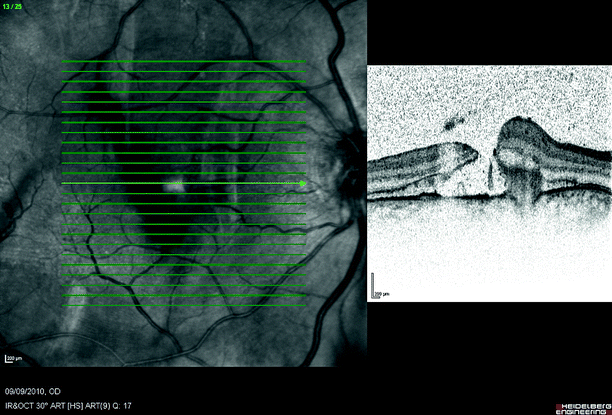
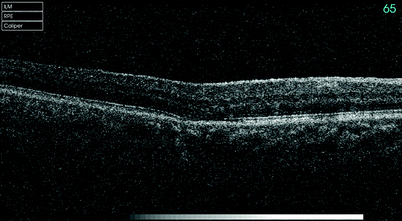

Fig. 14.19
This eye was struck by an elasticated cord used for holding luggage on a roof rack. This has caused choroidal ruptures seen on an OCT lifting the retina (see Fig. 14.20)

Fig. 14.20
See previous figure

Fig. 14.21
In the fovea, there is evidence of a macular hole

Fig. 14.23
See previous figure
14.3.2 Types of Retinal Break
Dialysis

Fig. 14.24
This patient had been struck in the eye by a tennis ball 9 months previously. There is now an RRD with inferotemporal dialysis
In blunt trauma, the commonest break is an inferotemporal dialysis then superonasal (see Chap. 6), which because of the slow onset of detachment may not become symptomatic until months or years after the injury when the macula detaches. Occasionally, an avulsion of the vitreous base is seen comprising a strip of ciliary epithelium, ora serrata and immediately post-oral retina into which the basal vitreous gel remains inserted. This ‘bucket handle,’ often in the supranasal quadrant, hangs down in the vitreous cavity. The free posterior edge of torn retina becomes detached. Beware that some patients can present with giant dialysis (90–360°) in contusion injuries.
Pars Ciliaris Tears
In a few cases, retinal tears may be found in the non-pigmented epithelium of the pars ciliaris, therefore difficult to detect, typically causing a slow-onset shallow retinal detachment (Alappatt and Hutchins 1998). This should be considered in children with a poor history and a chronic RRD.
Ragged Tear in Commotio Retinae
In severe injury, the choroid and retina have an ischaemic and haemorrhagic appearance (sclopetaria) and can produce a ragged degenerative break that may be large. This should be treated by observation at first, but these can cause retinal detachment and be associated with vitreous haemorrhage when intervention is indicated (Martin et al. 1994).
Giant Retinal Tears
Occasionally, posterior-vitreous-detachment-related tears can be seen most classically giant retinal tears but occasionally U tears.
Note: In contusion injury, it is often possible to wait and see what develops.

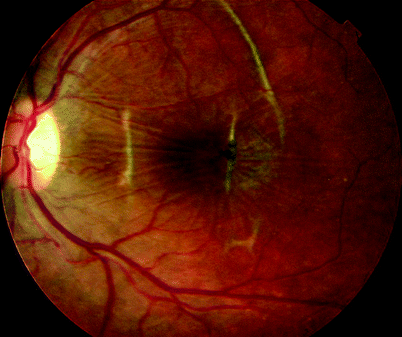
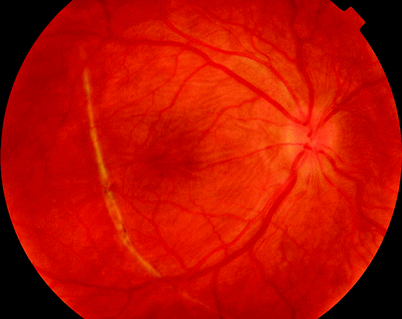
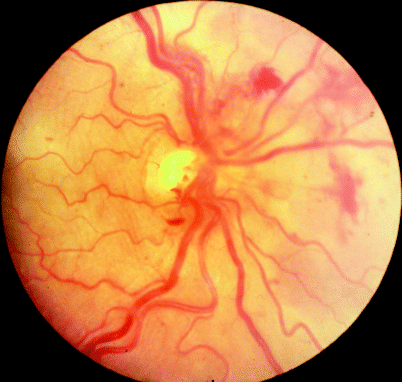
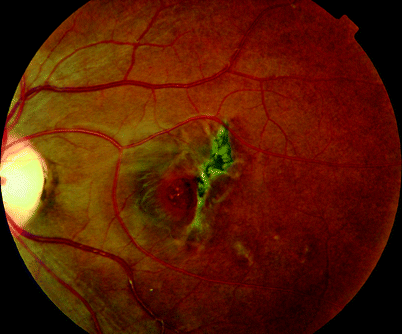
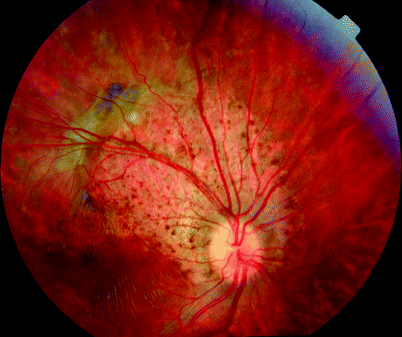

Fig. 14.25
This patient who suffered macular oedema from a severe blunt trauma also produced a macular hole

Fig. 14.26
Choroidal ruptures occur in blunt trauma and are seen as circumferential white lines. In this case, one is very close to the fovea. These patients can produce type II choroidal neovascular membranes from these defects

Fig. 14.27
A long choroidal rupture from contusion injury caused by a fist hitting the eye during an assault. Notice associated macular wrinkling

Fig. 14.28
The shock wave from a high-velocity projectile is enough to disrupt the structure of the retina

Fig. 14.29
A traumatic macular hole adjacent to a choroidal rupture. Surgery did not close the hole perhaps because of adhesion to the rupture site

Fig. 14.30
This patient has suffered trauma diffusely to the eye from a football injury resulting in retinal pigment epithelial changes which come very close to the fovea and reduce the central vision
14.3.3 Surgery
Table 14.1
Difficulty rating for surgery for contusion injury
Difficulty rating | Moderate |
Success rates | Low |
Complication rates | Low |
When to use in training | Late |
Posterior segment surgery may be necessary for:
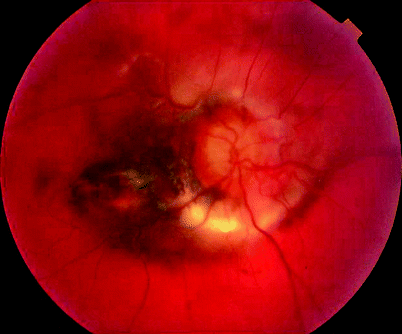

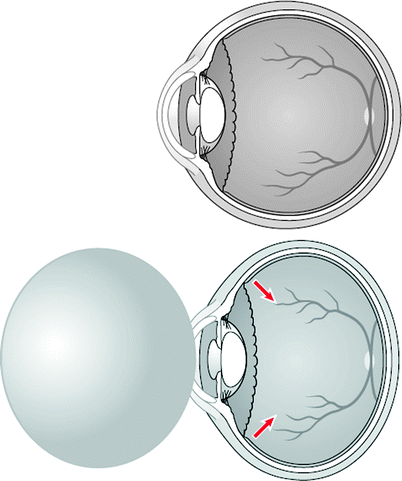
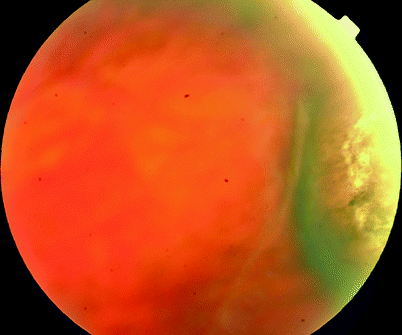
1.
Dislocation or subluxation of the lens
2.
Vitreous haemorrhage
3.
Choroidal haemorrhage
4.
Retinal detachment
5.
Macular hole

Fig. 14.31
This patient has suffered an avulsed optic nerve from trauma. This is evidenced by choroidal ruptures and subretinal haemorrhage around the optic nerve

Fig. 14.32
The late sequelae from optic nerve avulsion are seen with widespread chorioretinal damage around the nerve head and extending into the macula

Fig. 14.33
A squash ball is ideally sized to transfer all its energy to the same sized globe. The impact causes distortion of the globe which allows the vitreous base to move inwards (arrows) relative to the adjacent sclera, the probable mechanism for retinal dialysis formation

Fig. 14.34
In blunt injuries, the vitreous base can become separated from the retina
Dislocation of the Lens (see Chap. 16)
Vitreous haemorrhage can be dealt with by PPV, but be aware that there is likely to be other intraocular injury. The haemorrhage can be very thick, and the cutter may not be as efficient in its removal. There may or may not be a PVD.
Choroidal haemorrhage will usually break through into the vitreous cavity sometimes causing hyphaema (in severe cases eight-ball hyphaema, i.e. complete, with a risk of corneal staining) and erythroclastic glaucoma. On insertion of the infusion cannula (use a 6-mm cannula if necessary), take extra care not to infuse suprachoroidal fluid by checking the cannula through all layers.
Note: When the view is very poor, it may be useful to put the infusion (with small-gauge instrumentation, insert the cannula without using the stent) in through the limbus into the AC. Once some of the anterior vitreous haemorrhage has been cleared with the cutter, the infusion can be moved to its usual position and be checked visually before switching on.
Switch on the infusion. When fashioning the superior sclerotomies, green liquefied blood will exit via the sclerotomies. Usually, considerable residual clot remains in the suprachoroidal space. It is not usually possible to remove this. Excise the vitreous cavity haemorrhage whilst being aware of the chorioretinal elevation. Silicone oil is inserted to prevent further vitreous cavity opacity. As the choroidal haemorrhage resolves over weeks or months, under fill of the silicone oil will become apparent causing refractive visual disturbance. Rarely, a suprachoroidal cystic space remains, permanently elevating the retina and choroid.
Retinal detachment can occur from a variety of breaks requiring the appropriate surgical approach:


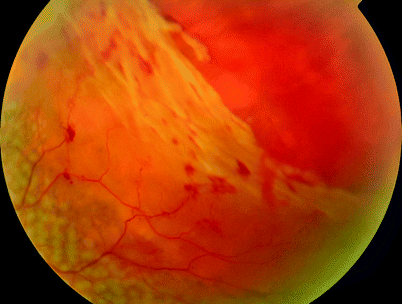
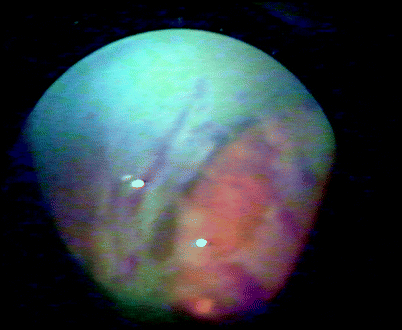


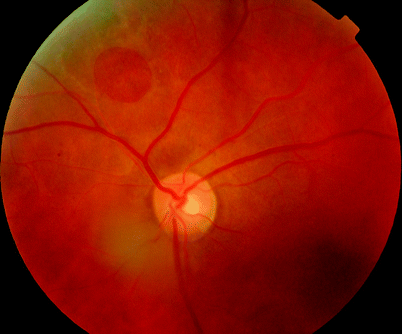

2.
Pars ciliaris tear which can be treated by non-drain procedure. These tears are usually seen superotemporally and can be difficult to detect (Dobbie and Phillips 1962; Long and Danielson 1953). Suspect this clinical feature in a child with an unexplained retinal detachment with an attached gel even without a history of trauma. A shallow indent with a solid silicone explant over the defect or 360° is sufficient to treat the condition.
3.
Ragged retinal tears. These can be treated with non-drain repair if not too big or posterior, in which case a PPV is required. In the latter, be aware that the posterior hyaloid membrane may require detachment from the posterior pole. Although this is potentially problematic through damaged commotio retinae, in practice the vitreous separates without further tearing of the retina.

Fig. 14.35
The retinas are shown from a 13-year-old who was suffering from domestic violence. She presented with bilateral inferotemporal dialyses and whilst awaiting operation was struck in the left eye. She then presented with a tear at the posterior edge of the RRD in the left eye which presumably occurred from a shock wave of SRF ripping the retina at the time of the blow (see Figs. 14.36–14.38)

Fig. 14.36
See previous figure

Fig. 14.39
This eye was struck by a soccer football and suffered a contusion injury with a ragged tear from disintegration of the retina in an eye with vitreous attached. The edge was lasered and the retina monitored for extension of the SRF but it progressed requiring PPV

Fig. 14.40
This patient was struck in the eye with a champagne cork. This caused a localised retinal detachment with a typical traumatic ragged break which was treated by plombage

Fig. 14.41
This patient was struck in the eye resulting in the development of a giant retinal tear

Fig. 14.42
A retinal break in retinal detachment with commotio retinae

Fig. 14.43
This patient noticed a floater after being struck in the eye. He had an operculated retinal break above the disc which was lasered but was very unlikely to progress, operculum visible in Fig. 14.44

Fig. 14.44
See previous figure
Retinal detachment may occur early from proliferative vitreoretinopathy in a severely traumatised and haemorrhagic eye (for surgery, see Chap. 7).
Macular holes can be treated by surgery (see Chap. 8).
14.3.4 Visual Outcome
The visual outcome is dependent on the mechanism of injury, but contusion injury severe enough to require vitreoretinal intervention is associated with only a 50 % chance of better than 20/200 vision.
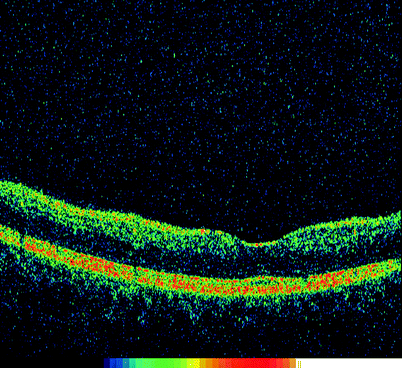

Fig. 14.45
This patient shows thin retina after blunt trauma which was associated with restricted visual recovery
14.4 Rupture
14.4.1 Clinical Presentation
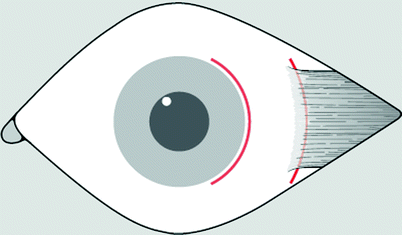
Fig. 14.46
The common sites of globe rupture from blunt trauma are at the limbus and just behind the extraocular muscles where the coats of the eye are at their weakest
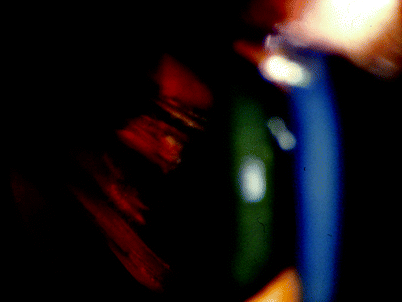
Fig. 14.47
An anterior incarceration site from a scleral rupture is present with vitreous and haemorrhage being dragged into the wound
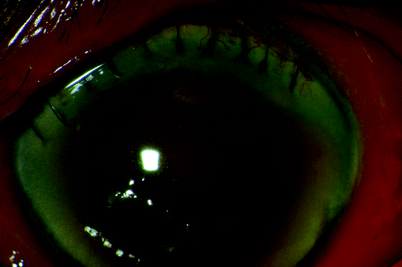
Fig. 14.48
Patients with pre-existing wounds are prone to rupture of the wound site in trauma. This patient suffered rupture of her wound site (from previous extracapsular cataract extraction) after falling and hitting the eye on the corner of some furniture
Blunt trauma may rupture the eye wall most commonly the sclera at the limbus or posterior to the extraocular muscle insertions often with immediate loss of the crystalline lens and prolapse of the choroid and retina. Old surgical wounds are also prone to opening, for example, corneal grafts and extracapsular cataract extraction wounds. Rupture may be commoner than anticipated. In one study, 72 % of eyes with severe blunt trauma had scleral ruptures, 47 % of these were undetected preoperatively (Russell et al. 1988). Computed tomography (CT) cannot be relied upon to detect globe rupture (Joseph et al. 2000). The severe fibrotic response that trauma induces (Winthrop et al. 1980) leads to a high incidence of retinal detachment which may progress rapidly to closed-funnel detachments within weeks. Surgical exploration of the globe is advised. Incarceration of vitreous, choroid and retina into scleral ruptures causes traction on these structures.
In practice, if rupture is present, the posterior segment is often disrupted with choroidal and vitreous haemorrhage, and there is a deepened anterior chamber. Take care not to exacerbate extrusion of intraocular contents by applying pressure top the globe during examination or surgery.
Note: The IOP in rupture may be normal or even high because the scleral rupture may block off with intraocular tissue.
Ultrasound can be employed but with copious contact jelly to avoid direct pressure on the damaged globe.
Note: In eyes with rupture of the globe, primary closure with vitreoretinal intervention at 2 weeks, if necessary, is advised.


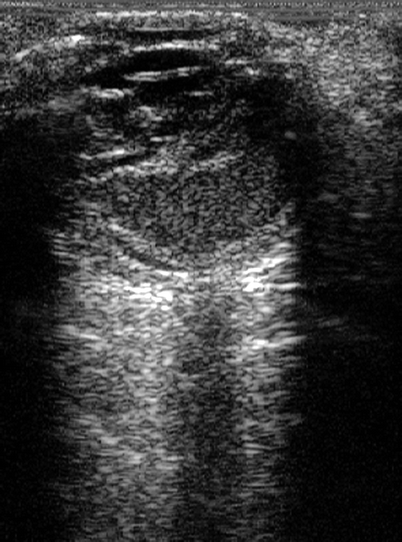
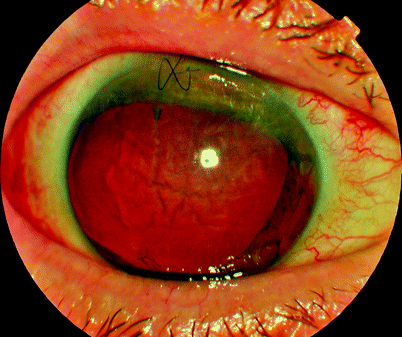



Fig. 14.50
An ultrasound at presentation

Fig. 14.51
By waiting 2 weeks, the interpretation of the structures of the posterior segment on ultrasound was improved, allowing identification of surgical landmarks. The vitreous gel was incarcerated into the scleral wound causing it to detach, leaving subhyaloid haemorrhage and an area of tractional RD from the disc to the incarceration

Fig. 14.52
In the early postoperative period, after PPV the anterior segment was much improved, and the retina could be viewed (see Fig. 14.53)

Fig. 14.53
See previous figure
14.4.2 Surgery
Table 14.2
Difficulty rating for surgery for rupture
Difficulty rating | High |
Success rates | Low |
Complication rates | High |
When to use in training | Late |

Fig. 14.54
This patient suffered blunt trauma with a haemorrhagic globe. The eye is being explored. A scleral rupture was discovered at 12 o’clock where the lens has been extruded from the eye and was found encapsulated underneath the superior rectus
In more severe blunt injury in which the globe cannot be examined clinically to exclude rupture, a surgical exploration of the globe should be considered. A primary repair of any scleral laceration should be performed with abscission of any extruding intraocular tissues to allow a clean closure of the sclera. Some surgeons advocate the use of 7/0 nylon for posterior ruptures; however, I have found adequate closure with 7/0 Vicryl.
The timing of the vitrectomy to clear vitreous haemorrhage is a balance between allowing some settling of immediate inflammation and engorgement of the eye and the risk of development of a closed-funnel retinal detachment from PVR. A PPV at 2–3 weeks is suggested. The lens is frequently lost through the wound so that the use of a 6-mm-long infusion cannula to avoid suprachoroidal infusion of fluid is safe and often recommended. Once the view of the retina has been obtained by careful vitrectomy, the incarceration site should be examined. If the rupture is at the corneo-scleral limbus, retinal involvement may be minimal, and if the vitreous haemorrhage is not too severe, PPV can be avoided allowing spontaneous clearance. If the retina is incarcerated, a retinectomy may be necessary to avoid dragging of the retina and tractional or secondary rhegmatogenous retinal detachment. However, not all incarcerations will progress, and some can be observed to watch for progression. Silicone oil insertion is recommended if intervention has been performed because of the risk of ongoing PVR formation. Unfortunately, these eyes are prone to late PVR even with silicone oil in or weeks after silicone oil removal.
Surgical Pearl of Wisdom
Before turning on the infusion cannula, it is important to look and verify proper positioning in the vitreous cavity. In complex cases where the view in to the eye is poor, it may be difficult to see the tip of the infusion cannula. Purposefully allow a few air bubbles in the infusion fluid so when it is turned on you can see the bubbles behind the IOL or lens. This confirms the infusion cannula is in vitreous cavity.
Stay updated, free articles. Join our Telegram channel

Full access? Get Clinical Tree



